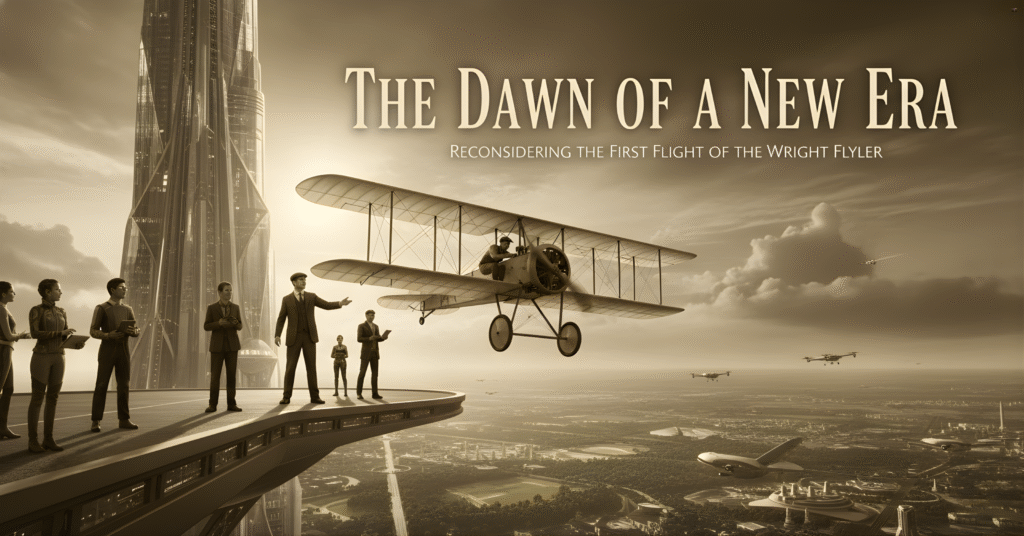The Dawn of a New Era: Reconsidering the First Flight of the Wright Flyer
Wright Flyer First Flight: How 12 Seconds Changed the World We’ve all seen the black-and-white photo: a fragile-looking contraption of wood and fabric hovering just above the ground. On December 17, 1903, the Wright Flyer made the first sustained, powered flight in history. But to reduce this event to a mere “first” is to miss its true revolutionary impact. This wasn’t just a short hop; it was the moment humanity learned the grammar of flight. The Problem: Why Everyone Else Was Failing Before the Wright brothers, the quest for flight was dominated by failure. The common approaches were fundamentally flawed. The “Power-Is-Everything” Myth: Many pioneers, like the well-funded Samuel Langley, believed a powerful engine was the key. They built machines designed to simply overpower the air, which led to uncontrolled and disastrous crashes. The Lack of Control: These early attempts treated aircraft like ships or cars, focusing on going straight ahead or steering like a boat. They lacked a system for maintaining balance and stability in a three-dimensional, fluid environment like the air. Trial and Error Over Science: Experimentation was often reckless and unsystematic, lacking the rigorous data collection needed to understand the principles of aerodynamics. The Wright Brothers’ Genius: A Different Philosophy Wilbur and Orville Wright succeeded where others failed because they asked a different question. Instead of “How do we get into the air?” they asked, “How do we control a vehicle in the air?” Their methodical approach as bicycle mechanics was their greatest advantage. Observation as Inspiration: By watching birds twist their wings to maneuver, they identified the need for lateral control—the ability to roll. The Breakthrough of “Wing Warping”: They invented a system of cables that could twist, or “warp,” the wings of their glider to mimic the birds’ motion. This was the cornerstone of their three-axis control system. Systematic Experimentation: They spent years testing gliders at Kitty Hawk, treating each trip as a scientific mission. They built a homemade wind tunnel to gather precise data on wing shapes, making them the world’s first true aeronautical engineers. December 17, 1903: What Really Happened at Kitty Hawk The first flight day was not a single event, but a series of four tests that proved their concept worked. A Hostile Environment: The conditions were far from ideal—freezing temperatures and winds gusting over 20 mph. The First Attempt (10:35 AM): With Wilbur at the controls, the Flyer lifted off, but stalled and landed after just 3.5 seconds, covering 60 feet. It was more of a hop. The Pivotal Second Flight: With Orville now piloting, the Flyer stayed airborne for 12 seconds, covering 120 feet. Crucially, this was the first controlled flight, with Orville actively operating the controls to maintain stability against the wind. Building Confidence: The third and fourth flights lasted 15 and then 59 seconds, covering an incredible 852 feet. Wilbur’s final flight demonstrated sustained, controlled, and powered flight beyond any doubt. The Key Takeaway: The success wasn’t the distance or the airtime; it was the demonstrable control. The Wright Flyer was a vehicle, not a projectile. The Immediate Aftermath: A Quiet Revolution The world did not immediately change. The reaction was one of surprising indifference. The brothers sent a telegraph to their father announcing “success four flights,” but the news was largely ignored or met with skepticism by the press. There were no cheering crowds. The brothers simply packed up the damaged Flyer and returned to Ohio to improve their design, focusing on securing patents. This quiet period highlights that their achievement was an intellectual and engineering breakthrough first, and a public spectacle later. The Ripple Effect: How a 59-Second Flight Shaped Our Modern World The true legacy of the Wright Flyer is the world we live in today. Its success created ripples that expanded to touch every aspect of modern life. The Death of Distance: Continents that were weeks apart by ship are now just hours away. This reshaped global trade, tourism, and family connections. Global Supply Chains: The concept of overnight shipping and global logistics, which powers our modern economy, is a direct descendant of that first flight. A New Military Domain: The Flyer’s legacy includes the concept of air power, reconnaissance, and the strategic reality of controlling the skies. A New Perspective: From the first aerial photographs to the iconic “Blue Marble” image of Earth from space, flight gave us a new way to see our planet and our place in the universe. Conclusion: More Than a Machine The Wright Flyer was not just an aircraft; it was a powerful idea made manifest. It proved that the secret to flight was not to conquer the sky, but to understand and collaborate with its forces. Every time an airplane takes off, it retraces the path first carved by two brothers from Dayton who, with patience, data, and brilliance, gave humanity its wings.
The Dawn of a New Era: Reconsidering the First Flight of the Wright Flyer Read More »


